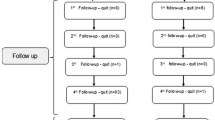Abstract
Introduction
Chronically hospitalized patients are often burdened with skin ulcerations, which may be persistent and even irreversible. Treatment with hyaluronic acid is widely used in the early phases of the ulcers to relieve symptoms and accelerate the healing process. The present study hypothesized that lysine hyaluronate (Lys-HA) (Lysial®, Fatai-Nyl Srl; Jasper LLC, Lugano, Switzerland), a new formulation of hyaluronic acid, would improve the healing of decubitus ulcers more than the commonly used sodium hyaluronate (SH). A double-blind randomized controlled trial was designed to assess the superiority of Lys-HA versus SH on decubitus ulcer size reduction over a 15-day period, and on the time necessary to reach 50% lesion size regression.
Methods
After a clinical evaluation, 50 hospitalized patients with decubitus ulcers were divided into three groups according to ulcer stage (stage 1: erythema and edema; stage 2: all-thickness skin destruction; stage 3: destruction of subcutaneous tissue) and randomized to receive Lys-HA or SH. Digital photographs were taken before the start of treatment, then every 3 days, and at the end of the study. Pre- and posttreatment differences in each group were tested using Student t tests and analysis of covariance with basis values as covariates.
Results
Ulcer reduction was greater in all the Lys-HA groups than SH groups. In stage 1 patients, 90% and 70% lesion size reductions were observed in the groups allocated to Lys-HA and SH, respectively (P<0.05). In stage 2 patients, 70% and 40% lesion size reductions were observed in the Lys-HA and SH groups, respectively (P<0.02). In stage 3 patients, 71% and 29% lesion size reductions were observed in the Lys-HA and SH groups, respectively (P<0.01). The regression time of 50% of lesion size was shorter in all the Lys-HA groups than SH groups (P<0.05).
Conclusion
The use of Lys-HA in the healing process of decubitus ulcers provides an improved efficacy with respect to SH in hospitalized patients, suggesting its use from the early phases of ulceration.
Similar content being viewed by others
References
Black J, Baharestani MM, Cuddigan J, et al. National Pressure Ulcer Advisory Panel’s updated pressure ulcer staging system. Urol Nurs. 2007;27:144–150.
Cuddigan J, Frantz RA. Pressure ulcer research: pressure ulcer treatment: a monograph from the National Pressure Ulcer Advisory Panel. Adv Wound Care. 1998;11:294–300.
Reddy M, Gill SS, Kalkar SR, Wu W, Anderson PJ, Rochon PA. Treatment of pressure ulcers: a systematic review. JAMA. 2008;300:2647–2662.
Thomas DR. Does pressure cause pressure ulcers? An inquiry into the etiology of pressure ulcers. J Am Med Dir Assoc. 2010;11:397–405.
Reddy M, Gill SS, Rochon PA. Prevention of pressure ulcers: a systematic review. JAMA. 2006;296:974–984.
Whitney J, Phillips L, Aslam R, et al. Guidelines for the treatment of pressure ulcers. Wound Repair Regen. 2006;14:663–679.
European Pressure Ulcer Advisory Panel and National Pressure Ulcer Advisory Panel. Prevention and treatment of pressure ulcers: quick reference guide. Washington DC: National Pressure Ulcer Advisory Panel; 2009.
O’Regan M, Martini I, Crescenzi F, De Luca C, Lansing M. Molecular mechanisms and genetics of hyaluronan biosynthesis. Int J Biol Macromol. 1994;16:283–286.
Scott JE. Secondary structures in hyaluronan solutions: chemical and biological implications. Ciba Found Symp. 1989;143:6–15.
Fraser JR, Laurent TC, Laurent UB. Hyaluronan: its nature, distribution, functions and turnover. J Intern Med. 1997;242:27–33.
Norton D. Calculating the risk: reflections on the Norton scale. Decubitus. 1989;2:24.
Woodbury MG, Houghton PE. Prevalence of pressure ulcers in Canadian healthcare settings. Ostomy Wound Manage. 2004;50:22–24,26,28,30,32,34,36–38.
Ferrell BA, Josephson K, Norvid P, Alcorn H. Pressure ulcers among patients admitted to home care. J Am Geriatr Soc. 2000;48:1042–1047.
McDonald JA, Camenisch TD. Hyaluronan: genetic insights into the complex biology of a simple polysaccharide. Glycoconj J. 2002;19:331–339.
Author information
Authors and Affiliations
Corresponding author
Rights and permissions
About this article
Cite this article
Felzani, G., Spoletini, I., Convento, A. et al. Effect of lysine hyaluronate on the healing of decubitus ulcers in rehabilitation patients. Adv Therapy 28, 439–445 (2011). https://doi.org/10.1007/s12325-011-0016-2
Received:
Published:
Issue Date:
DOI: https://doi.org/10.1007/s12325-011-0016-2




